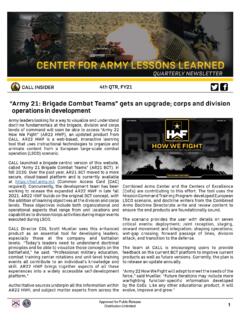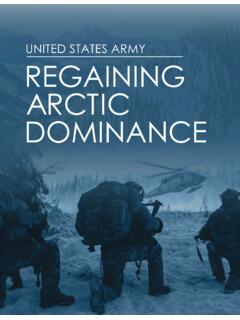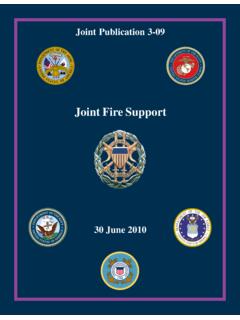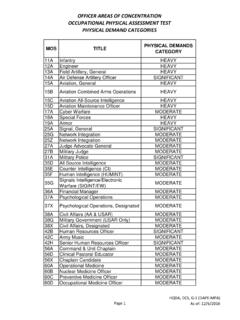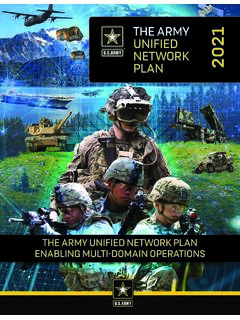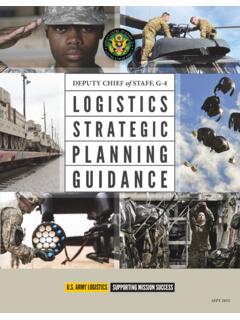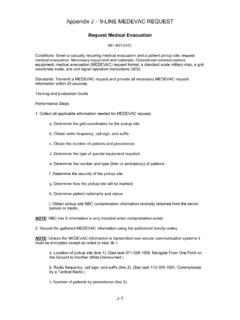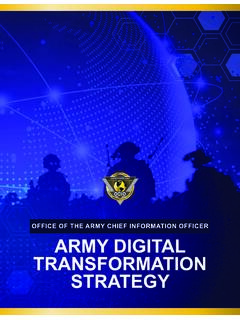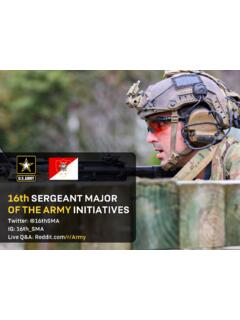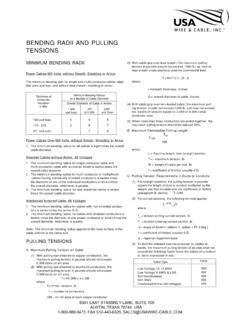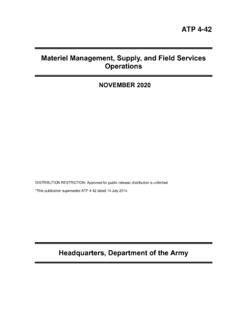Transcription of The Army in Military Competition - United States Army
1 The army in Military Competition Chief of Staff Paper #2 Headquarters, Department of the army 1 March 2021 Distribution Restriction: Approved for public release; distribution is unlimited. iii CSA Paper #2 1 March 2021 Table of Contents Preface .. ii Executive Summary .. iv Chapter I. An Overview of Competition .. 1 Chapter II. The army in Narrative Competition : Building and Portraying Strength .. 8 Chapter III. The army in Direct Competition : Competition , Crisis, and Deterrence .. 11 Chapter IV. The army in Indirect Competition : From Cooperation to Deterrence.
2 14 Chapter V: Competition in Action .. 17 Chapter VI: Conclusion .. 20 Appendix A: army Activities and Effects in Military Competition .. 22 Appendix B: Select References on Competition .. 30 iv CSA Paper #2 1 March 2021 Executive Summary Definition of Military Competition Military Competition encompasses the range of activities and operations employed to achieve political objectives and to deny adversaries the ability to achieve objectives prejudicial to the United States . Armed conflict is one element of what is termed the Competition continuum in joint doctrine.
3 The focus of this publication is the set of activities that occur outside of armed conflict. These might be taken to directly achieve objectives without fighting or they might be part of preparations for armed conflict meant to both deter adversaries and to ensure the Joint Force begins a conflict on the most favorable terms. In all instances, the Joint Force competes as part of a national strategy that integrates all instruments of power to accomplish objectives. The army contributes to Military Competition by building and employing land force capability and capacity to support a broad range of policy choices.
4 Military activities during Competition support other instruments of national power as part of a coordinated strategic approach to achieve policy aims. Military activities during Competition can be either defensive or offensive; lethal or non-lethal; unilateral or multilateral; employ conventional, irregular, and special operations forces from each of the Military services in multiple domains. Military activities during Competition preserve and expand friendly ( , allies, and partners) advantages while limiting or eroding adversary options, imposing costs, and increasing adversary doubts.
5 They can establish deterrence and set the conditions for Military success when deterrence fails. Services contribute to Military Competition by resourcing capabilities and presence, as well as by fostering and maintaining relationships that yield access and influence. Combatant Commands compete through the employment of forces in engagement, exercises, security cooperation, and other activities to achieve desired outcomes in Competition and create favorable conditions in case of crisis and armed conflict. The Three Dynamics of Military Competition : Narrative, Direct, and Indirect Competition The scope, scale, and complexity of great power Competition requires it to be broken into manageable subordinate parts.
6 This paper describes three basic dynamics of Competition distinguished by their differing objectives, methods, and scope. Some capabilities and activities will be more effective or relevant to one dynamic than the others depending on considerations such as thresholds of acceptable risk or the intensity of the Competition . The three dynamics of Competition are a tool to help force developers, planners, and commanders to work through this complexity as they generate and employ army forces in Competition . The three dynamics provide a means to understand what kinds of capabilities are most useful within a specific context, as well as how success or failure in those individual cases aggregate into the overarching v CSA Paper #2 1 March 2021 great power Competition .
7 It is not sufficient to focus on just one of the three dynamics of Competition while ignoring the others. All play a role. The first dynamic is narrative Competition , which is reflected in the rise and fall of a country s reputation based on general perceptions of its strength, reliability, and resolve (see figure E1). Narrative Competition is on-going, open-ended, and larger than any single event or issue. It is the connection linking multiple subordinate instances of Competition over specific issues into the larger whole. Narrative Competition is enduring and cumulative; the reputation of the United States accumulates over time.
8 A reputation for strength and reliability is a significant competitive benefit that might cause adversaries to seek less ambitious objectives or, in some instances, to choose not to compete at all and seek cooperation instead. Similarly, a strong reputation can encourage allies and partners to compete on a specific issue with more confidence. Despite this power, narrative Competition only goes so far. The United States could be preeminent in global reputation, yet still be unable to effectively compete for a specific issue because it has not built the relationships, lacks presence, or simply does not have capabilities relevant to the situation.
9 Direct Competition occurs when Competition occurs over a well-defined interest of such overriding importance to the United States as to make armed conflict a plausible means of achieving or preserving the desired ends. Put simply, it is an issue worth fighting over. It should be noted that though the issue is important enough to justify war, direct Competition typically takes place at levels of intensity far below crisis much less armed conflict. Thus, direct Competition encompasses the full range of competitive activities from the lowest intensity Competition below armed conflict through general state conflict.
10 This gives policymakers a wide array of tools to employ according to how intensely they want to pursue the objective and how much risk they are willing to accept. In direct Competition , the objective is to create leverage for the United States and to deny it to the adversary. Figure E1 The Three Dynamics of Competition The army contributes to narrative Competition by being a lethal, competent, credible force and being recognized as such by key audiences among allies and partners as well as by adversaries. vi CSA Paper #2 1 March 2021 Indirect Competition occurs when the interests of the United States are not so important, are less defined, or are not inherently in tension with the adversary.
